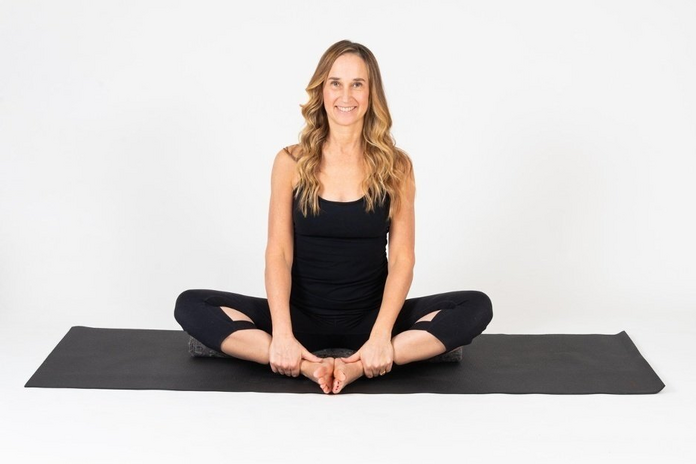For the past three years, Dena Jensen has been sharing her love of yoga as an adjunct professor at George Mason. Through both beginner and immediate courses, Dena has guided hundreds of Mason students through the ancient practice of yoga. Amidst all the academic stress that college brings, Dena’s beloved one-credit courses supply students with a much needed inhale and exhale.
The on-going coronavirus pandemic has brought many changes to the yoga community. Many yoga classes have transitioned to an online format while other smaller studios have been forced to close their doors. Although the yoga community is presently struggling, hope remains on the horizon. During these distressing times, many have turned to yoga as a way to alleviate stress and promote overall well being. In the words of Dena, “Yoga is the perfect medicine for the times we are in right now.”
I was fortunate enough to be able to sit down with Dena to discuss her eighteen-year history with the yoga community, how coronavirus has impacted her instruction, and yoga’s lengthy history and profound health benefits.
Marissa Joyce (MJ): What initially attracted you to the yoga practice and how long have you been practicing?
Dena Jensen (DJ): I had suffered with low back pain since I was in college. The pain got worse with age and after the birth of my son. Through the years I tried everything to find relief including muscle relaxants, chiropractic adjustments, massage, acupuncture and more. One day, about 18 years ago, I saw a sign that said “YOGA” and I thought, other than one very overcrowded class at the YMCA, I hadn’t really given yoga a try yet. Attending classes at a yoga studio versus the one YMCA class made all the difference for me. My body, mind, and soul fell head over heels for this ancient practice. I couldn’t get enough of everything that yoga had to offer and my back pain started to lessen the grip it had on me. Yoga was not only the most important practice for relieving my back pain, but it also truly transformed the rest of my life. I had no idea much my life would change when I stepped onto my mat for the first time, but I am deeply grateful that I walked into Sun & Moon Yoga studio 18 years ago!
MJ: How long have you been an Adjunct Yoga Instructor at George Mason and what is your favorite aspect about teaching in the Mason Community?
DJ: I started teaching at George Mason in the Fall of 2017. There are so many things I love about teaching at GMU it’s hard to know where to start! My favorite aspect of teaching are the students I get to meet and introduce yoga to. It’s an absolute delight to pass on this practice and yoga teachings to the students at Mason. They are so receptive, attentive, and engaged in the teachings that they make me even more excited about teaching them. There’s something very special about introducing yoga to a beginner. I learn a lot from them, maybe more than they learn from me! I am also grateful that I get to teach Intermediate Yoga. Students who catch the yoga bug and have room in their schedule take this course. We really dive into the philosophy and the deeper meaning of the practice in this class. It’s an absolute delight to share the teachings with students who see the powerful changes that begin to happen in their lives because of their practice!
MJ: How is yoga unique to other physical fitness activities?
DJ: This is a really great question. A lot of people think of yoga only as a physical fitness activity, but it is so much more than that! Yoga teachings are at least 5,000 years old! Modern yoga looks quite different than ancient yoga, but the roots of yoga are ancient and deep. In modern yoga, it might feel like physical exercise, but the intention and purpose of yoga is to quiet the mind. That purpose has stayed the same from ancient times in India until today. Yoga is often defined as the union of the body, mind, and spirit. So the purpose and intention of the physical practice of yoga is to quiet the mind and to feel whole.
In the West, we practice what is called hatha yoga. Hatha yoga is one branch of the tree of yoga. It emphasizes physical postures (asana) and breath practices (pranayama). Hatha yoga may feel like an exercise class because you are putting the body into different shapes or poses and moving the body a lot, but there is also a great emphasis on staying present and combining your movement with breath throughout the class. This is done to keep you fully in the present moment during the entire yoga practice. Another way that yoga is unique is the structure of the class. Most, if not all, yoga classes begin with a centering practice and end with final relaxation (shavasana). In between the centering and relaxation, you move through postures and breath. This experience of going back and forth through calming and activating experiences is deeply satisfying for the nervous system.
A final principle of yoga that makes it unique is the emphasis on energy. The postures which make up hatha yoga have been designed to move energy through the body and open up any blocked energy. This is something you feel for yourself after a good yoga class. Because you have moved energy through the body you feel refreshed, calm, peaceful, and balanced!

DJ: The emphasis that is placed on staying mindful and present while moving the body and breathing is deeply satisfying to the nervous system. The brain gets to take a break from all the thinking it usually does and fully engage in the present moment, resulting in a sense of deep wellbeing and improved mental health. Yoga also teaches us there is a life force called prana which directly affects the energy body. There are specific techniques for breathing called pranayama designed to move prana in the body. These breath techniques tap directly into the nervous system and can be activating or calming. When we learn these breathing techniques we move our life force through the body and feel refreshed and at peace. The posture practice puts the body into new and interesting shapes. The physical benefits of postures are numerous and include improved flexibility, increased muscle strength, enhanced lung capacity, increased blood flow, strengthened bone density, improved immune functioning, and better sleep!
MJ: In your opinion, what is the biggest misconception about yoga?
DJ: The biggest misconception about yoga is thinking that it is only another form of exercise! The second biggest misconception is that you have to be flexible to do yoga.
MJ: How has the ongoing pandemic impacted the yoga community and your work as an instructor?
DJ: I now teach yoga completely online. It was a hard adjustment at first because I needed to learn so many new skills to teach yoga in this new way, but it’s getting easier and 6 months into this pandemic, I’m actually starting to enjoy teaching online. Unfortunately, the yoga community is struggling. Many studios are closing their physical doors and many never open up again. The hardest hit are the small, independent studios. Small businesses are struggling nationwide and yoga studios are not immune. It’s a period of deep uncertainty.

DJ: Yes, I do find that people are searching for ways to relieve their stress, increase their wellbeing, soothe their distress, and move their bodies. Yoga is the perfect medicine for the times we are in right now.
MJ: If someone is intimidated by the practice, what is your advice to them?
DJ: Yoga is for everyone! The guiding light in yoga is non-harming. Find a teacher who understands that yoga is meant for every *body*, who gives clear instruction with many variations to try out, knows how to teach beginners, and empowers you to make the yoga fit your body instead of trying to force your body into the yoga. There are so many styles and brands of modern yoga. Some classes are fast and vigorous, others are slow and gentle, some hold poses, others move and flow with every breath. There’s a type of yoga called restorative yoga where you use props to relax into supportive poses and hold them for long periods of time which is profoundly relaxing and calming. Some yoga has specific poses that are repeated in every class, others vary from class to class. One benefit of this pandemic is the variety and depth of online classes available. You can now learn from teachers around the world, not just at your local studio or gym. Try out different classes and teachers until you find the yoga that fits you!

DJ: I think studying with a teacher is best, especially for beginners. There’s a lot of free yoga, but remember you get what you pay for! Taking a class at your university, if they offer it, is a wonderful introduction to yoga. I really like the online platform Yoga International for the information they provide about yoga and the classes they offer. A few other online platforms include Yogaglo, Gaia, and Yoga Anytime. The local studio where I teach offers a huge variety of yoga classes on Zoom and many are great for beginners. There are so many options now available. I would not use Instagram as a primary way to learn yoga or even watch yoga being practiced! I do follow a lot of excellent yoga teachers on Instagram and I also post there, but much of what you see on Instagram is very distorted so I would advise to use social media in a limited way when learning more about yoga. Don’t get discouraged if the first few attempts at yoga don’t meet your needs. Keep looking around until you find the yoga that feels delicious in your own beautiful body!
Namaste, collegiettes! You can find more information about George Mason’s yoga classes here.



